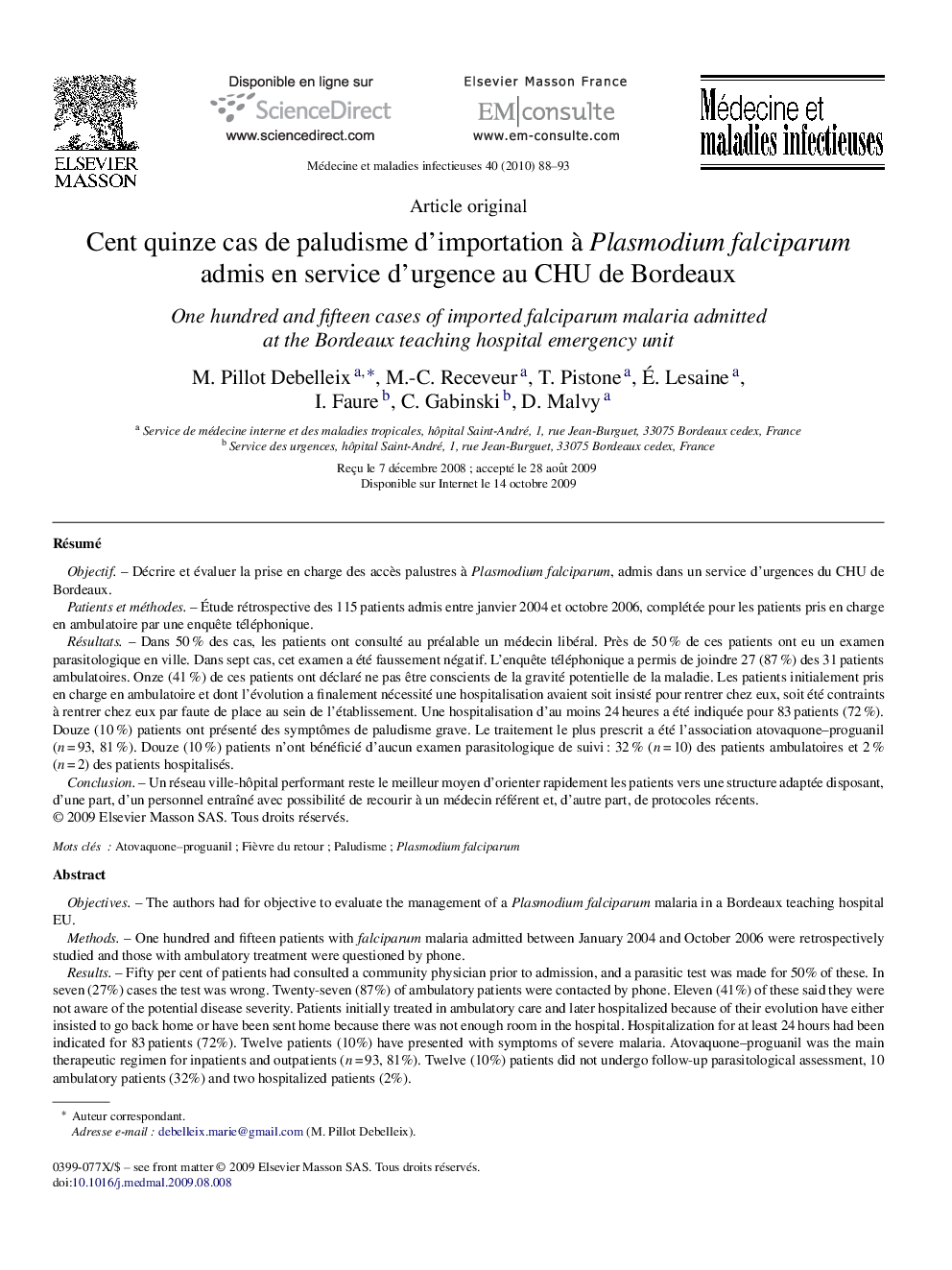| کد مقاله | کد نشریه | سال انتشار | مقاله انگلیسی | نسخه تمام متن |
|---|---|---|---|---|
| 3413564 | 1224300 | 2010 | 6 صفحه PDF | دانلود رایگان |

RésuméObjectifDécrire et évaluer la prise en charge des accès palustres à Plasmodium falciparum, admis dans un service d’urgences du CHU de Bordeaux.Patients et méthodesÉtude rétrospective des 115 patients admis entre janvier 2004 et octobre 2006, complétée pour les patients pris en charge en ambulatoire par une enquête téléphonique.RésultatsDans 50 % des cas, les patients ont consulté au préalable un médecin libéral. Près de 50 % de ces patients ont eu un examen parasitologique en ville. Dans sept cas, cet examen a été faussement négatif. L’enquête téléphonique a permis de joindre 27 (87 %) des 31 patients ambulatoires. Onze (41 %) de ces patients ont déclaré ne pas être conscients de la gravité potentielle de la maladie. Les patients initialement pris en charge en ambulatoire et dont l’évolution a finalement nécessité une hospitalisation avaient soit insisté pour rentrer chez eux, soit été contraints à rentrer chez eux par faute de place au sein de l’établissement. Une hospitalisation d’au moins 24 heures a été indiquée pour 83 patients (72 %). Douze (10 %) patients ont présenté des symptômes de paludisme grave. Le traitement le plus prescrit a été l’association atovaquone–proguanil (n = 93, 81 %). Douze (10 %) patients n’ont bénéficié d’aucun examen parasitologique de suivi : 32 % (n = 10) des patients ambulatoires et 2 % (n = 2) des patients hospitalisés.ConclusionUn réseau ville-hôpital performant reste le meilleur moyen d’orienter rapidement les patients vers une structure adaptée disposant, d’une part, d’un personnel entraîné avec possibilité de recourir à un médecin référent et, d’autre part, de protocoles récents.
ObjectivesThe authors had for objective to evaluate the management of a Plasmodium falciparum malaria in a Bordeaux teaching hospital EU.MethodsOne hundred and fifteen patients with falciparum malaria admitted between January 2004 and October 2006 were retrospectively studied and those with ambulatory treatment were questioned by phone.ResultsFifty per cent of patients had consulted a community physician prior to admission, and a parasitic test was made for 50 % of these. In seven (27 %) cases the test was wrong. Twenty-seven (87 %) of ambulatory patients were contacted by phone. Eleven (41 %) of these said they were not aware of the potential disease severity. Patients initially treated in ambulatory care and later hospitalized because of their evolution have either insisted to go back home or have been sent home because there was not enough room in the hospital. Hospitalization for at least 24 hours had been indicated for 83 patients (72 %). Twelve patients (10 %) have presented with symptoms of severe malaria. Atovaquone–proguanil was the main therapeutic regimen for inpatients and outpatients (n = 93, 81 %). Twelve (10 %) patients did not undergo follow-up parasitological assessment, 10 ambulatory patients (32 %) and two hospitalized patients (2 %).ConclusionAn efficient hospital-community network and recent protocols are the best tools to rapidly refer patients to an adapted structure with available trained staff and referent specialist.
Journal: Médecine et Maladies Infectieuses - Volume 40, Issue 2, February 2010, Pages 88–93